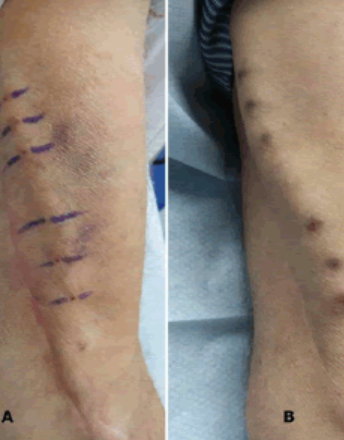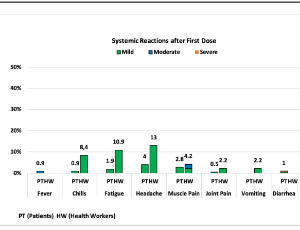Loading
Archives of Nephrology and Renal Studies
ISSN: 2771-1889

2021
Volume 1, Issue 1, p1-33
Articles published in this issue are Open Access and licensed under Creative Commons Attribution License (CC BY NC) where the readers can reuse, download, distribute the article in whole or part by mentioning proper credits to the authors.
Percutaneous Ablation of Localized Renal Masses: An Updated Review
Kimberly A. Maciolek, Noah S. Schenkman
With readily available cross-sectional imaging, asymptomatic localized renal masses (LRMs) are often incidentally found. The standard management for LRM has been surgical resection, however, detection of masses that are benign or with low metastatic risk has led to interest in minimally invasive alternatives such as percutaneous thermal ablation (TA) or active surveillance
Arch Nephrol Ren Stud, 2021, Volume 1, Issue 1, p1-9 | DOI: 10.33696/nephrology.1.001
Safety of Using Rituximab Therapy During COVID-19 Pandemic
Hatem Ali, Mohammed Elshafey, Mahmoud M Mohamed
Rituximab is a chimeric (20% rodent and 80% human) monoclonal antibody that binds to the CD20 antigen present on the cell surface and leads to depletion of mature B-cells [1,2]. It is the first approved monoclonal antibody to be used in the therapy of indolent B-cell non- Hodgkin’s lymphoma and chronic lymphocytic leukemia
Arch Nephrol Ren Stud, 2021, Volume 1, Issue 1, p10-15 | DOI: 10.33696/nephrology.1.002
The Role of Direct Oral Anticoagulants in Advanced Chronic Kidney Disease – Questions and Future directions
Filip Ionescu, Saima Mansuri
With the advent of the direct oral anticoagulants (DOACs), patients requiring anticoagulation for common conditions such as atrial fibrillation and venous thromboembolism no longer need to worry about dietary restrictions or regular monitoring of the international normalized ratio which complicated warfarin treatment.
Arch Nephrol Ren Stud, 2021, Volume 1, Issue 1, p16-20 | DOI: 10.33696/nephrology.1.003
How Well Do Hemodialysis Patients Respond to the BNT162b2 mRNA COVID-19 Vaccine?
Fernando Carrera, Joana Costa, Luciano Pereira, Marco Marques, Belarmino Spencer, Francisco Ferrer
In January 2020, the World Health Organization (WHO) classified COVID-19 to be a Public Health Emergency of International Concern and declared it a pandemic on March 11, 2020 [1]. Over one hundred and eighty-five million people have been infected by SARS-CoV-2 and roughly four million have died worldwide so far
Arch Nephrol Ren Stud, 2021, Volume 1, Issue 1, p21-27 | DOI: 10.33696/nephrology.1.004
Commentary on: “Multiple Single Cannulation Technique of Arteriovenous Fistula: A Randomised Controlled Trial”
Ricardo Peralta, Rui Sousa, Bruno Pinto, Pedro Gonçalves, Carla Felix, João Fazendeiro Matos
One of the most important renal nursing procedures is the cannulation of a vascular access (VA), a procedure that is carried out on every single dialysis treatment. VA cannulation method is still a procedure that reflects local unit practices and the skill of the individual nurse
Arch Nephrol Ren Stud, 2021, Volume 1, Issue 1, p28-33 | DOI: 10.33696/nephrology.1.005
Recommended Articles
Safety of Using Rituximab Therapy During COVID-19 Pandemic
Rituximab is a chimeric (20% rodent and 80% human) monoclonal antibody that binds to the CD20 antigen present on the cell surface and leads to depletion of mature B-cells [1,2]. It is the first approved monoclonal antibody to be used in the therapy of indolent B-cell non- Hodgkin’s lymphoma and chronic lymphocytic leukemia
How Well Do Hemodialysis Patients Respond to the BNT162b2 mRNA COVID-19 Vaccine?
In January 2020, the World Health Organization (WHO) classified COVID-19 to be a Public Health Emergency of International Concern and declared it a pandemic on March 11, 2020 [1]. Over one hundred and eighty-five million people have been infected by SARS-CoV-2 and roughly four million have died worldwide so far
Commentary on: “Multiple Single Cannulation Technique of Arteriovenous Fistula: A Randomised Controlled Trial”
One of the most important renal nursing procedures is the cannulation of a vascular access (VA), a procedure that is carried out on every single dialysis treatment. VA cannulation method is still a procedure that reflects local unit practices and the skill of the individual nurse
Safety and Efficacy of s-MOX Regimen in Patients with Colorectal Cancer Who Developed Cardiotoxicity Following Fluoropyrimidine Administration: A Case Series
5-fluorouracil (5-FU), an antimetabolite in the fluoropyrimidine class, is the third most commonly used chemotherapeutic agent worldwide for the treatment of solid malignancies [1]. Despite advances in novel cancer therapies, commonly used in combination with fluoropyrimidines, 5-FU remains one of the most effective and safe chemotherapy agents to manage colorectal cancer (CRC).
Dexamethasone: The First Drug to be Shown to Decrease Mortality in Critically Ill Patients with COVID-19
The precise role of corticosteroids for treatment of coronavirus disease 2019 (COVID-19) is unclear due to lack of randomized trials.
How to Prevent Rehospitalization in Patients with COVID-19
Since December 2019, Severe Acute Respiratory Syndrome Coronavirus 2 (SARS-CoV-2) caused by 2019 Novel Coronavirus (2019-nCoV) has resulted in 89,000 cases of Corona Virus Disease 2019 (COVID-19), formerly known as Novel Coronavirus Pneumonia (NCP) in China, including 2,450 deaths.
The Safety of High Dose Labetalol in the Pregnant Population
Medical management of hypertension in pregnancy is indicated for severe range blood pressures. This is diagnosed with either systolic blood pressure (SBP) ≥ 160 mm Hg and/or diastolic blood pressure (DBP) ≥110 mm Hg on two occasions at least 4 hours apart. When this diagnosis is established, fast-acting anti-hypertensive medications can be utilized for acutely severe range blood pressures.
Preparing for a More Public Health-Aware Practice of Medicine in Response to COVID-19
After one year in a pandemic, we mourn the loss of over half a million lives in the United States, and over four million worldwide, and remain concerned over the challenges facing the families of 35 million people in the United States, and 200 million worldwide, who have suffered from cases of COVID-19.
The Use of Hydroxychloroquine and Interferons for the Prophylaxis of COVID-19
At the beginning of Covid-19 pandemic, we proposed to use hydroxychloroquine (HCQ) and intranasal interferon (IFN) a-2b spray to prevent SARS-CoV-2.
Remdesivir in COVID-19 Patients with End Stage Renal Disease on Hemodialysis
COVID-19, a global pandemic caused by severe acute respiratory syndrome-coronavirus 2 (SARS-CoV2) has resulted in hospitalization in many cases.
Hyperglycemia and diabetes in hospitalized patients with COVID-19
The prevalence of diabetes in COVID-19 patients ranges from 5.3% to 58% representing the second comorbidity after hypertension. However, when adjusted for age, diabetes prevalence among COVID-19 patients is similar to its prevalence in the general population.
Management of Diagnostic and Treatment Centers in the Second Wave of COVID-19
COVID-19 has challenged global health and affected many countries. The disease had infected more than 16 million people and killed over 650,000 ones by the end of July 2020. According to Sahu et al., COVID-19 epidemic is the third most common coronavirus in the 21st century, resulting in numerous deaths all over the world. It has caused severe psychological stress and increased hospital visits along with increased tiredness and burnout of medical staff. The disease has also raised many problems for the management of hospitals and diagnostic-treatment centers, so that many of them have no capacity to receive patients.
News About the Extracellular Vesicles from Mesenchymal Stem Cells: Functions, Therapy and Protection from COVID-19
The present Commentary is a critical follow-up of a previous review about “Extracellular vesicles, news about their role in immune cells: physiology, pathology and diseases”, appeared in Clinical and Experimental Immunology last June 2019 [1].
Possible Therapeutic Use of Natural Compounds Against COVID-19
The outbreak of severe acute respiratory syndrome-coronavirus-2 (SARS-CoV-2) has led to coronavirus disease-19 (COVID-19); a pandemic disease that has resulted in devastating social, economic, morbidity and mortality burdens. SARS-CoV-2 infects cells following receptor-mediated endocytosis and priming by cellular proteases.
Ectodomain Shedding May Play a Pivotal Role in Disease Severity in COVID-19
Ectodomain shedding mediated by a disintegrin and metalloprotease 10/17 (ADAM10/17) modulates the function of immune effector cells and may be involved in the novel coronavirus disease COVID-19. Toll-like receptor 7/8 (TLR7/8) recognizes single-strand RNA from viruses such as severe acute respiratory syndrome coronavirus 2 (SARS-CoV-2, the virus that causes COVID-19) during the innate immune response
Adapting the Escape Room to Engage Learners Two Ways During COVID-19
When creating the project, “An Escape Room Simulation Focused on Renal-Impairment for Prelicensure Nursing Students” [1] the author’s goal was to increase positive health outcomes for patients with acute kidney injury (AKI). AKI is complicated, but nurses who can help identify those at risk for the disorder and help initiate early treatment can improve patients’ results.
BeEAM Conditioning for Autologous Transplant in Lymphoma: A Review of the Evidence, Safety and Efficacy
The ground-breaking PARMA and CORAL trials have substantiated high dose chemotherapy (HDCT) and autologous stem cell transplantation (ASCT) as standard of care in the treatment of chemosensitive and relapsed Non-Hodgkin’s Lymphoma (NHL). Additionally, the regimen has proven effective in the treatment of relapsed and resistant Hodgkin’s Lymphoma (HL). Globally, carmustine (BCNU), etoposide, cytarabine and melphalan (BEAM) has been the most widely used conditioning regimen of the past 30 years. BEAM conditioning is generally well-tolerated and effective, with the most common toxicity being oral and gastrointestinal mucositis. Despite this, some transplant centres have transitioned from BEAM HDCT to a newer regiment referred to as BeEAM, which replaces BCNU for bendamustine. The movement appears to be primarily driven by a worldwide scarcity of BCNU, which has led to affordability issues. This dramatic rise in drug cost is not insignificant. Between 2013 and 2015, the price of BCNU increased from $200 (CAD) / 100 mg vial to $4,965.14 (CAD) / 100 mg vial.
Blood Compatibility in Various Hemodialysis Membrane Materials: A Review
In hemodialysis therapy for end-stage kidney disease (ESKD) patients, blood and dialysate are brought into contact through the dialysis membrane to remove waste products and excess water. When blood contacts the dialysis membrane, blood cells, coagulation system, fibrinolysis system, kallikrein system, and complement system are activated. Therefore, dialysis membranes with excellent blood compatibility must be chosen to avoid such reactions to occur. In this article, we review blood compatibilities of each dialysis membrane material.
Potentials of Interferons and Hydroxychloroquine for the Prophylaxis and Early Treatment of COVID-19
Severe acute respiratory syndrome coronavirus 2 (SARS-CoV2) causes a mild respiratory infection in most individuals. However, a portion of patients develop a severe infection resulting in the need for mechanical ventilation and ultimately death. Currently, the median infection fatality rate of coronavirus disease 2019 (COVID-19) is estimated to be 0.27% .
Role of BCG in Reduction of the Spread and Severity of COVID-19
Bacille Calmette Guerin (BCG) vaccine has existence of more than 80 years with its widest use among all currently available vaccines [1]. BCG vaccine developed from a virulent attenuated M. bovis strain against tuberculosis (TB) by deleting more than 14 different regions in the genome of Mycobacterium [2].
About Scientific Archives
Scientific Archives is a global publisher initiated with the mission of ensuring equal opportunity for accessing science to research community all over the world. Spreading research findings with great relevance to all channels without any barrier is our goal. We want to overcome the challenges of Open Access with ensured quality and transparency.
